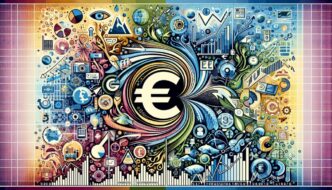The recent report from the Commerce Department has sent shockwaves through the financial community, revealing that the U.S. economy grew at a surprising rate in the third quarter of the year. These latest figures show that gross domestic product (GDP) rose by 3.1%, significantly higher than the previously reported 2.8%. Economists and investors alike are grappling with the implications of this upward revision.
Understanding the Economic Growth Report
On Thursday, the Commerce Department released its latest GDP report, which details the health of the U.S. economy. Here are some key highlights:
- Growth Rate: GDP increased by 3.1%, marking a robust revision from the earlier report.
- Expectations: Economists anticipated the growth rate would remain unchanged, making the new figure particularly surprising.
- Sector Contributions: Key sectors contributing to this growth include consumer spending, business investment, and exports.
Implications for Investors
Given this unexpected economic growth, here are several implications and insights for investors:
1. Market Reactions
Financial markets typically respond swiftly to economic data. A stronger-than-expected GDP growth report can lead to:
- Stock Market Rally: Investors might move into growth stocks, anticipating an economic expansion.
- Interest Rate Expectations: The Federal Reserve might adjust its monetary policy stance to combat potential inflation, affecting bond markets.
2. Sector Performance
Certain sectors may thrive in a growing economy. Here are a few sectors to keep an eye on:
| Sector | Potential Growth | Key Stocks |
|---|---|---|
| Consumer Discretionary | High | Amazon, Home Depot |
| Technology | Moderate | Apple, Microsoft |
| Financials | Positive | JPMorgan Chase, Bank of America |
| Industrial | High | General Electric, Caterpillar |
Investors should evaluate these sectors for potential opportunities based on their growth prospects and market conditions.
3. Inflation Concerns
Growth can bring about inflationary pressures. Given the rise in GDP, investors should monitor:
- Consumer Price Index (CPI): Monitoring annual changes in the CPI can indicate inflation trends.
- Federal Reserve Policy: Investors should be aware of the Fed’s stance on interest rate hikes as they may respond to rising inflation.
Case Studies of Economic Growth Trends
To better understand the implications of economic growth, let’s examine a couple of recent examples:
Case Study 1: The Post-COVID Recovery
Following the severe contraction during the COVID-19 pandemic, the economy rebounded swiftly. This growth was fueled by:
- Government stimulus measures providing financial relief.
- Supply chain recovery as businesses reopened.
Many tech and consumer discretionary stocks benefited immensely during this recovery, demonstrating how economic rebounds can create opportunities for investors.
Case Study 2: The Great Recession
During the Great Recession in 2008, the economy faced significant challenges. However, the subsequent recovery showcased how distressed assets could turn profitable over time:
- Investors who identified hidden gems in real estate and financial stocks reaped considerable rewards as the economy regained its footing.
Practical Tips for Investors
As economic conditions fluctuate, here are practical tips for investors to consider:
- Diversify Your Portfolio: In uncertain times, ensure your investments span multiple sectors to mitigate risk.
- Stay Informed: Regularly follow economic indicators such as GDP, CPI, and unemployment rates.
- Consider Dollar-Cost Averaging: This strategy can reduce volatility by evenly spreading out investments over time.
What to Watch For
As we move forward, it’s imperative for investors to keep an eye on upcoming economic reports and Federal Reserve meetings. Some key aspects to monitor include:
- Next GDP Revisions: Adjustments to GDP figures can further influence market sentiment.
- Inflation Data: Rising prices could affect interest rates and dictate the investment landscape for 2024.
- Consumer Confidence Reports: These reports provide insights into consumer spending and overall economic health.
Conclusion
The unexpected GDP growth of 3.1% in Q3 presents both challenges and opportunities for investors. By staying informed about the economic landscape and being proactive in their investment strategies, investors can position themselves for potential success. As we look ahead, carefully monitoring economic indicators and sector performance will be critical for navigating this evolving market environment.
In an ever-changing economic landscape, adaptability remains key. Investors should remain vigilant and ready to seize opportunities presented by robust economic growth.







